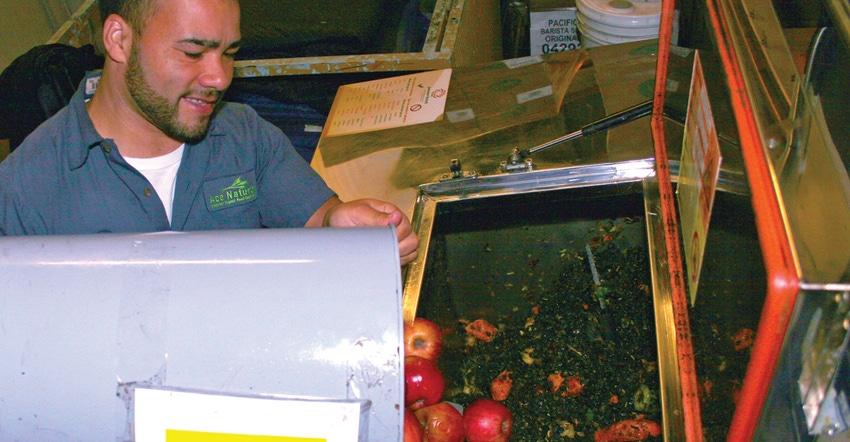Power Knot’s liquid food composters eliminate the need to haul away food scraps.

Ace Natural, a New York City-based distributor of organic produce and other foods, doesn’t pay to have food scraps hauled anymore. Rather, it uses a liquid composter installed on its property, negating the need to collect, wrap and load waste on to pallets and eliminating the need to store waste in its refrigerator and ship it to a composting facility.
Designed and manufactured by Power Knot in San Jose, Calif., the machine is called a liquid food composter, but it’s basically a small aerobic digester. The company sells the equipment around the world and in the U.S., mainly to the Army and hotels but also to some U.S. hospitals, grocers, a stadium and one large waste hauler. Power Knot President Iain Milnes sees the solid waste industry becoming a prime client type in time.
The liquid composter sits in a kitchen where food waste is continuously fed into it and processed inside a sealed drum. Water is periodically and automatically injected into the drum, and then a proprietary blend of micro-organisms is placed in the vessel, creating a large surface area to accelerate decomposition. Depending on the material, it will digest within 24 hours.
An additional feature is that data is accessible via the cloud, including volume entering the machine, volume digested, when to add scraps and landfill gas avoided.
There are other types of equipment besides Power Knot’s liquid composter available for commercial use in the U.S.
One is a true compost machine, which mixes waste over a couple of weeks and converts it into compost. However, it requires a lot of space, and generators have to produce about a ton a day for payoff, according to Milnes.
Then, there is a dehydrator that dries food into a powder. These machines don’t make compost themselves, but the powder can be further processed into compost, reducing volume but still generating greenhouse gas emissions.
“The third machine is our type that digests waste through an aerobic process, so there are no smells, and what’s left is grey water that goes down the drain and into the sewer,” says Milnes.
The load on the public wastewater system is minor: about 0.3 percent of sewage waste leaving his hotel clients’ properties comes from the machines, and the liquid composter uses only about 0.1 percent of the hotels’ energy, according to Milnes.
The main reason ACE installed this machine is that it’s a triple bottom line company, meaning it uses an accounting framework with social, environmental and financial parts, says Alberto Gonzalez, chief operating officer for Ace Natural.
“We care about how we conduct business, and when we were putting food waste in a truck and sending it to a composting facility, we were using a lot of resources. It was not efficient. So, for us, it was more related to our values. This liquid composter also helped us to be ready for the New York ban on commercial food waste. You have food that cannot go into landfill, and you need to figure out a way to dispose of it,” says Gonzalez.
Meanwhile, methane created from decomposing organics warms the planet 86 times more than carbon dioxide over 20 years, reports the Intergovernmental Panel on Climate Change.
“I think people underestimate the climate impact of landfilling organic waste. With the composter, it’s diverted, and it has operational benefits to the generator, as it’s not kept hanging around in a bucket where it can start to rot in few hours,” says Milnes.
The liquid composter comes in several sizes that process 25 pounds to 2,000 pounds daily. It can digest what would be considered hard to break down foods, such as lobster shells, fish bones and pineapple skins, which don’t have to be separated, though it took time to work out the technology.
“When we started, we thought we could take micro-organisms that eat protein, fat and other food scraps and stick them together, but it did not digest. So, creating the right blend of micro-organisms was key, which we did working with a third party,” says Milnes.
He thinks the solid waste industry will soon be a big customer due to increasing pressure to deal with organics.
“It’s tough to pick up a few hundred pounds of organics a month. The costs for renting the machine are on par with their costs to collect and haul waste. But operationally, it’s better for them,” states Milnes. “There is the customer satisfaction factor. The hauler benefits their customers who, increasingly, want to divert and show their customers they are environmentally responsible.”
About the Author(s)
You May Also Like




